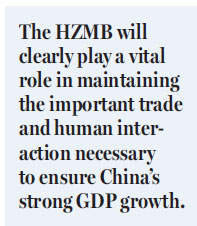'Bridge of Dreams' has finally become a reality
Updated: 2018-10-25 05:58
By Daniel de Blocq van Scheltinga(HK Edition)
|
|||||||||
Daniel de Blocq van Scheltinga points out that the HZMB has demolished an old myth that China was incapable of producing original engineering marvels
It seems not so long ago that many Western observers shared the view that China was incapable of producing its own design, technology or engineering, and merely copied everything from the West. The theory even went around, as published in The New York Times, that copying was an inherent part of Chinese culture and tradition, fostered by the way the written language was learned, namely by spending years memorizing thousands of characters needed to achieve literacy, and copying these, "single-mindedly and unquestioningly". That Western children also needed to copy the letters of the alphabet to learn how to write them seems to have been conveniently forgotten in this theory.

With the opening of the Hong Kong-Zhuhai-Macao Bridge, surely this idea must be banished to the rubbish bin. The world's longest sea bridge (beating the Jiaozhou Bay Bridge) is an engineering marvel, which has already proven itself to be strong enough to withstand the force of the recent Typhoon Mangkhut. It should also be noted that before this opening the top five longest bridges of any type in the world were all Chinese.
A number of elements made this bridge, which in reality is a combination of a bridge and tunnel, an engineering challenge: For example, the requirement that it be built to last for at least 120 years, combining different Hong Kong, Macao and mainland regulations and standards, having to consider the impact of frequent typhoons, crisscross navigation, airport height restrictions, and the high environmental standards.
The dimensions are by themselves impressive: The whole structure is 55 kilometers long and includes a 29.6-km dual three-lane carriage way in the form of a bridge-cum-tunnel. The HZMB was built with an impressive 420,000 tons of steel, according to one calculation, 60 times the amount of steel used to construct the Eiffel Tower in Paris. President Xi Jinping has called the HZMB "a bridge of dreams, self-confidence, and rejuvenation".
Even though the completion and opening were delayed as with most mega projects, it seems highly appropriate and symbolic that the opening was in the same year that the world celebrates the 40-year anniversary since the reform and opening-up of China was initiated by paramount leader Deng Xiaoping. As we all know today, the proposed changes, which Deng described as "China's second revolution", have resulted in an amazing and unprecedented economic success. In only four decades China has moved from being a very poor nation to becoming an economic superpower with the world's largest foreign reserves, the world's second highest GDP, and the third largest levels of foreign direct investment. As Xi rightly stated at the recent Boao Forum, "Reform and opening-up, China's second revolution, has not only profoundly changed the country but also influenced the whole world".
Four decades ago no one could have imagined China being capable of producing an engineering marvel such as the HZMB, although the idea was first touted by the famous Hong Kong entrepreneur-engineer Gordon Wu Ying-sheung of Hopewell Holdings, 35 years ago. Even then it must have seemed unlikely for many others. Bridge of Dreams is indeed an appropriate name!
It is also symbolic that the HZMB connects Hong Kong with Zhuhai, which was one of the original special economic zones created in the 1980s, following the first one in Shenzhen, all as part of the reform and opening-up. Hong Kong was then a British colony with its own different economic, political and legal systems. It was sometimes presented as the standard that China should aspire to, at least with regard to economic and financial matters. Today the relationship between mother and daughter has changed, and Hong Kong's economy benefits greatly from its unique status within the nation. The new physical connection can be seen as a long-term sign of this symbiotic economic interlinkage.
The HZMB was, as one could have expected, a very expensive infrastructure project. It will slowly but surely repay itself over time. Land transport between Hong Kong and Zhuhai will now take one hour and 15 minutes, instead of the three and a half hours in the past. Residents in Zhuhai and Macao will clearly have more international travel options now that Hong Kong International Airport is only an hour away from them.
And lastly, HZMB connects the three important partners in the Greater Bay Area initiative, Guangdong (nine cities), Macao and Hong Kong, which together are forecast to produce a GDP of $4.62 trillion (HK$36.2 trillion) by 2030 - larger than the Tokyo Bay Area or the New York Bay Area. The HZMB will clearly play a vital role in maintaining the important trade and human interaction necessary to ensure China's strong GDP growth.
The HZMB is a clear symbol of the New China: The old days of copycats are clearly over; it is breaking new ground and setting new standards for the world in many aspects of its economic achievements.
The author is an adviser on China-related matters to both the private and public sectors, and was the first non-Chinese CEO of a Chinese State-owned finance company.
(HK Edition 10/25/2018 page12)